 W
WThe Beloved is an oil painting on canvas by English artist Dante Gabriel Rossetti, first painted in 1865 and now in Tate Britain.
 W
WBullfight is an 1865-1866 painting by Édouard Manet, now in the Musée d'Orsay in Paris. It was produced after the artist's trip to Spain in 1865 and forms part of his Spanish period (1862-1867).
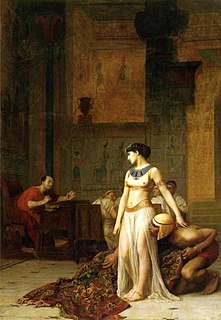 W
WCleopatra and Caesar, also known as Cleopatra Before Caesar, is an oil on canvas painting by the French Academic artist Jean-Léon Gérôme, completed in 1866. The work was originally commissioned by the French courtesan La Païva, but she was unhappy with the finished painting and returned it to Gérôme. It was exhibited at the Salon of 1866 and the Royal Academy of Arts in 1871.
 W
WThe Collector of Prints is a mid-19th century painting by French artist Edgar Degas. Done in oil on canvas, the painting is currently in the collection of the Metropolitan Museum of Art.
 W
WDancing Fairies is a painting by the Swedish painter August Malmström (1829–1901). The painting depicts fairies dancing above the water, in a moonlit landscape.
 W
WLe Déjeuner sur l'herbe is an 1865–1866 oil on canvas painting by Claude Monet, produced in response to the 1863 work of the same title by Édouard Manet. It remained unfinished, but two large fragments are now in the Musée d'Orsay in Paris, whilst a smaller 1866–1867 version is now in the Pushkin Museum in Moscow.
 W
WThe Fifer or Young Flautist is a painting by French painter Édouard Manet, made in 1866. It is usually kept in the Musée d'Orsay, Paris, and is now on loan to the Louvre Abu Dhabi museum in Abu Dhabi, UAE.
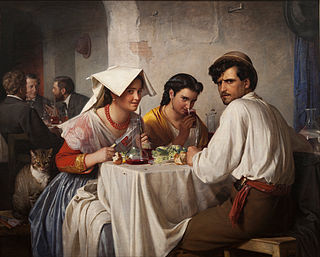 W
WIn a Roman Osteria is a painting by the Danish painter Carl Bloch. It was painted in 1866.
 W
WJo, the Beautiful Irishwoman is the title of a series of four oil on canvas bust-length portraits by Gustave Courbet. They all show the same redheaded Irish model Joanna Hiffernan looking in a mirror - she also modelled for Whistler. The works have minor differences in details and dimensions but their exact chronology is unknown. They are now in the Nationalmuseum, the Metropolitan Museum of Art, the Nelson-Atkins Museum of Art and a private collection.
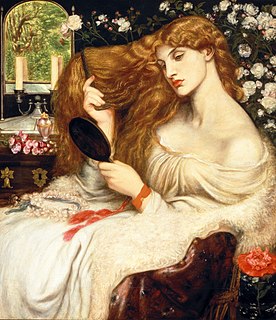 W
WLady Lilith is an oil painting by Dante Gabriel Rossetti first painted in 1866–1868 using his mistress Fanny Cornforth as the model, then altered in 1872–73 to show the face of Alexa Wilding. The subject is Lilith, who was, according to ancient Judaic myth, "the first wife of Adam" and is associated with the seduction of men and the murder of children. She is shown as a "powerful and evil temptress" and as "an iconic, Amazon-like female with long, flowing hair."
 W
WThe Matador Saluting is an oil on canvas painting produced by Édouard Manet between 1866 and 1867. Its precise date is unclear - Charles S. Moffett dates the first definite reference to the work to 1867, at an exhibition devoted to Manet's works at the pavillon de l'Alma.
 W
WMoema is an oil painting on canvas created in 1886 by Brazilian artist Victor Meirelles. It depicts the homonym character from the epic poem Caramuru (1781), by Santa Rita Durão. The work does not depict a scene from the poem, but instead Meirelles's personal interpretation of the character's fate, submerging into the water after being rejected by Caramuru.
 W
WMonna Vanna is an 1866 oil on canvas painting by Dante Gabriel Rossetti. It was acquired by the collector William Henry Blackmore and later entered the collection of George Rae, one of Rossetti's patrons. It later passed from Rae to the joint ownership of Arthur Du Cros and Otto Beit and it was purchased from them by the Tate Gallery in 1916 via the NACF – it is now in the collection of Tate Britain in London.
 W
WL'Origine du monde is a picture painted in oil on canvas by the French artist Gustave Courbet in 1866. It is a close-up view of the genitals and abdomen of a naked woman, lying on a bed with legs spread. The framing of the nude body, with head, arms and lower legs outside of view, emphasizes the eroticism of the work.
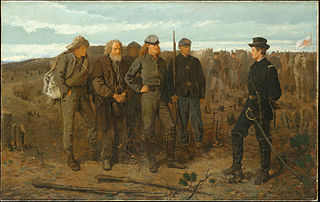 W
WPrisoners from the Front is a mid 19th-century painting by American artist Winslow Homer. One of Homer's most notable early works, the painting depicts a scene in which Confederate officers surrender to a Union officer during the American Civil War. Homer's experience as a war correspondent likely contributed to his rendering of the work.
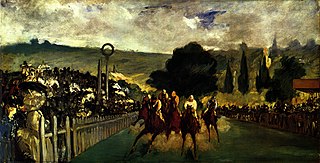 W
WThe Races at Longchamp is an 1866 painting by the French artist Édouard Manet. The Impressionist painting depicts a horse racing at Longchamp and is currently conserved at the Art Institute of Chicago. It has been exhibited many times, the first one at the École nationale supérieure des Beaux-Arts in Paris in January 1884.
 W
WRejtan, or the Fall of Poland is an oil painting by the Polish artist Jan Matejko, finished in 1866, depicting the protest of Tadeusz Rejtan against the First Partition of Poland during the Partition Sejm of 1773. Both a depiction of a historical moment, and an allegory for the surrounding period of Polish history, the painting is one of Matejko's most famous works, and an iconic picture of an emotional protest.
 W
WRemembrance of Tivoli is a painting by the German artist Anselm Feuerbach, produced during his 1866 stay in Rome. It shows two Italian peasant children in Tivoli. It is now in the Alte Nationalgalerie in Berlin.
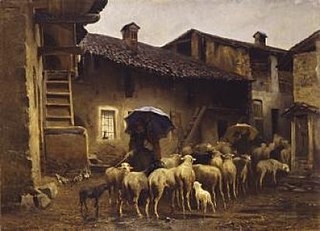 W
WReturn to the Sheepfold is a c.1866 painting by Carlo Pittara, originally entitled The Return, now in the Galleria civica d'arte moderna e contemporanea in Turin.
 W
WThe Rocky Mountains is an 1866 oil on canvas painting by a German-American painter Albert Bierstadt, a painter of Westward Expansion scenes in the latter 19th century. It is a landscape painted in a Luminist style.
 W
WThe Slave Market is an 1866 painting by the French artist Jean-Léon Gérôme. It depicts an unspecific Middle Eastern or North African setting where a man inspects the teeth of a nude, female slave.
 W
WLe Sommeil is an erotic oil painting on canvas by French artist Gustave Courbet created in 1866. The painting, which depicts a lesbian couple, is also known as the Two Friends and Indolence and Lust.
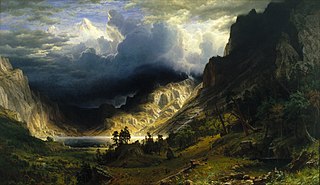 W
WA Storm in the Rocky Mountains, Mt. Rosalie is an 1866 landscape oil painting by German-American painter Albert Bierstadt that was inspired by sketches created on an 1863 expedition.
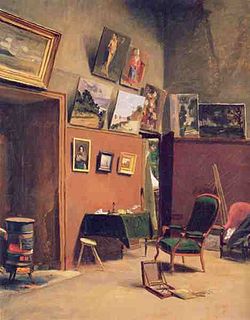 W
WStudio on Rue Furstenberg is an 1866 painting by Frédéric Bazille of the studio he was sharing with Claude Monet at 6 Place de Furstenburg in the 6th arrondissement of Paris in January 1866. Monet had painted his Le Déjeuner sur l'herbe in the same studio in 1865. One floor down in the same building was the studio used by Eugène Delacroix between 1857 and his death to be close to the église Saint-Sulpice, where he was painting a chapel – that studio was later used by Diogène Maillart, Delacroix's student, whilst working to win the first prize for painting in 1864. The whole building is now the Musée national Eugène-Delacroix.
 W
WUncle Tom and Little Eva is an oil on canvas painted by Edwin Longsden Long in 1866. It depicts a scene from the novel Uncle Tom's Cabin. The painting is kept at Russell-Cotes Art Gallery & Museum.
 W
WWoman in the Garden is a painting begun in 1866 by Claude Monet when he was a young man of 26. The work was executed en plein air in oil on canvas with a relatively large size of 82 by 101 cm. and currently belongs in the collection of the Hermitage Museum in St Petersburg, Russia.
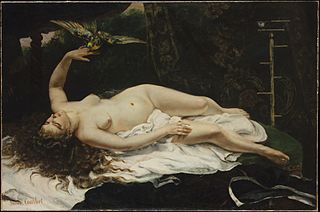 W
WLa Femme au perroquet is an oil painting on canvas by French artist Gustave Courbet. It was the first nude by the artist to be accepted by the Paris Salon in 1866 after a previous entry in 1864 was rejected as indecent. It is in the collection of the Metropolitan Museum of Art in New York city.
 W
WWomen in the Garden is an oil painting begun in 1866 by French artist Claude Monet when he was 26. It is a large work painted en plein air; the size of the canvas necessitated Monet painting its upper half with the canvas lowered into a trench he had dug, so that he could maintain a single point of view for the entire work. The setting is the garden of a property he was renting. His companion and future wife Camille Doncieux posed for the figures. Monet finished the work indoors, and used magazine illustrations to render fashionable clothing.
 W
WA Young Lady in 1866 or Lady with a Parakeet is an 1866 painting by Édouard Manet, showing his favourite model Victorine Meurent, wearing a pink gown, holding a small bouquet of violettes and accompanied by a parakeet. It is an oil painting on canvas measuring 185.1 x 128.6 cm, and is now in the Metropolitan Museum of Art in New York. It and Boy Carrying a Sword were the first of Manet's works to enter a gallery collection.